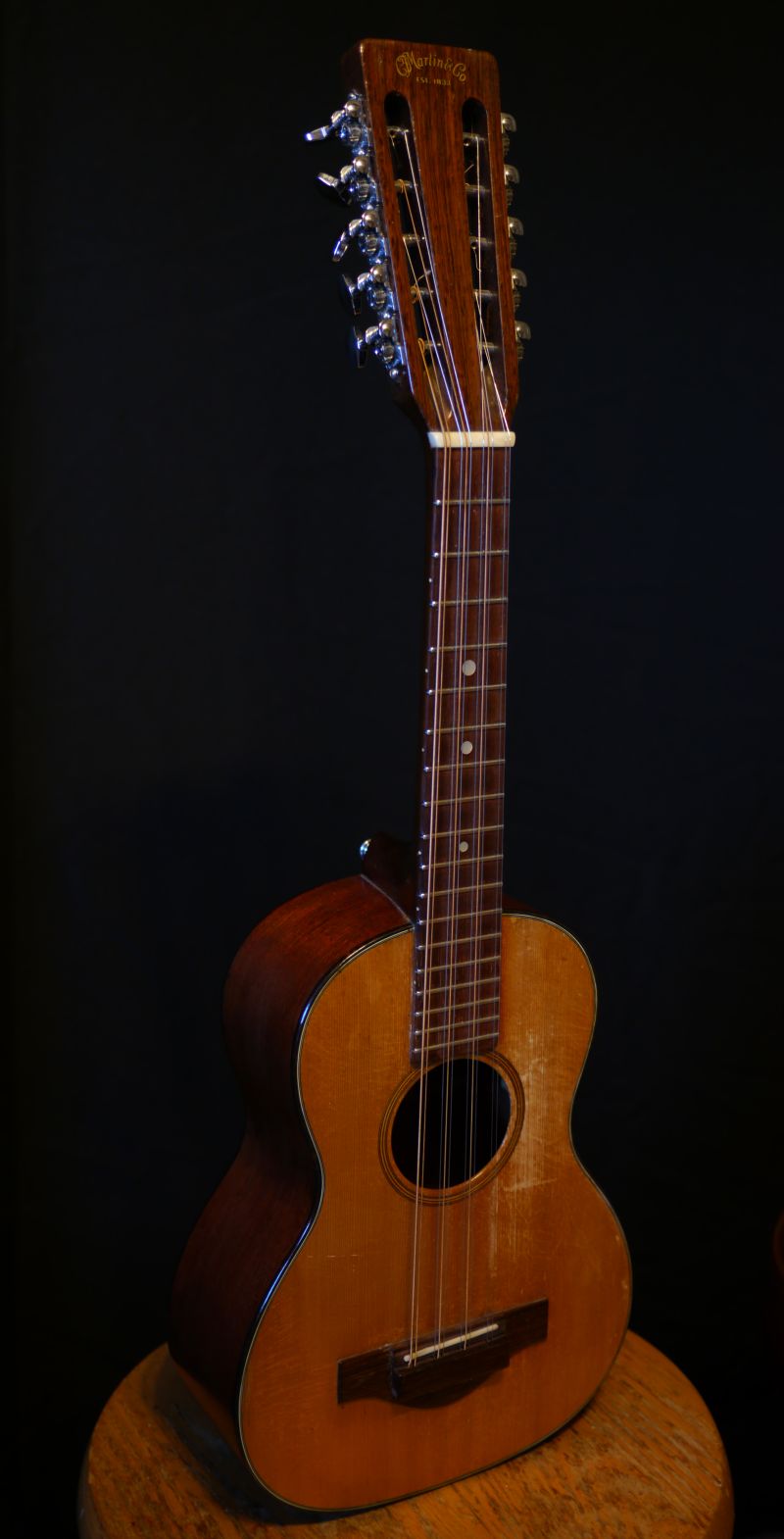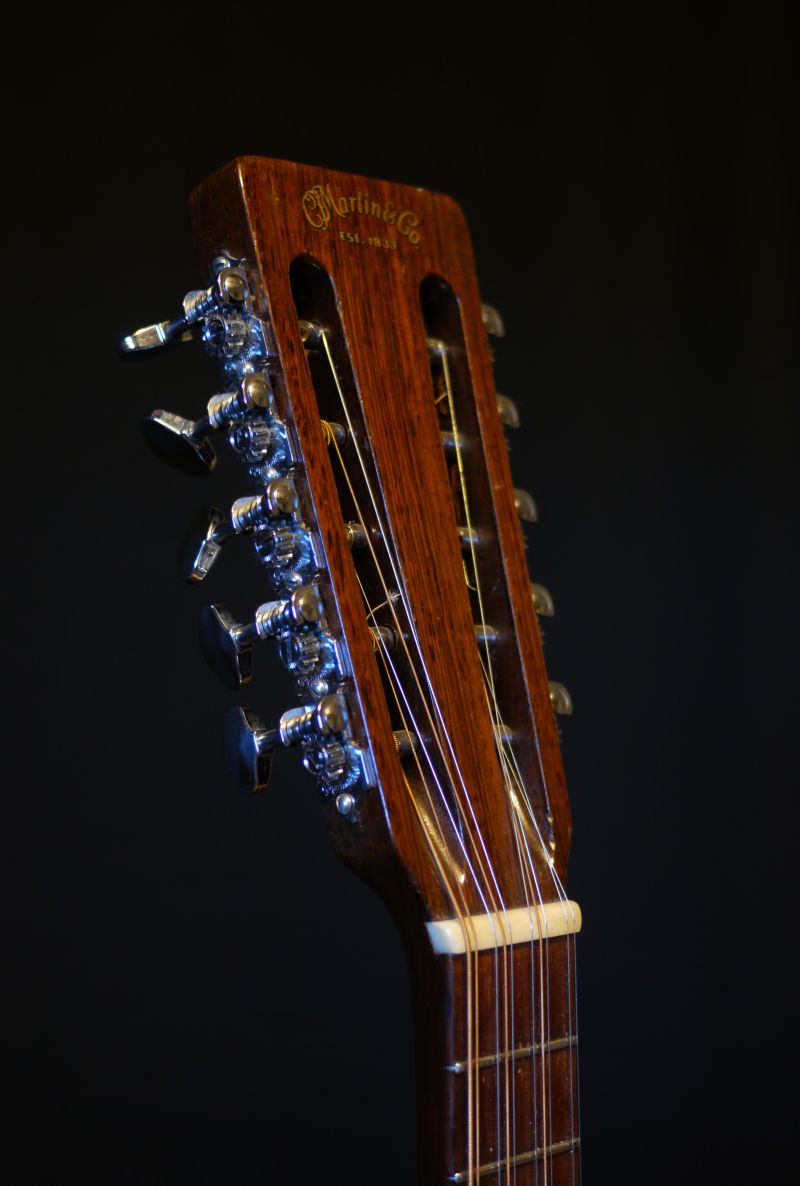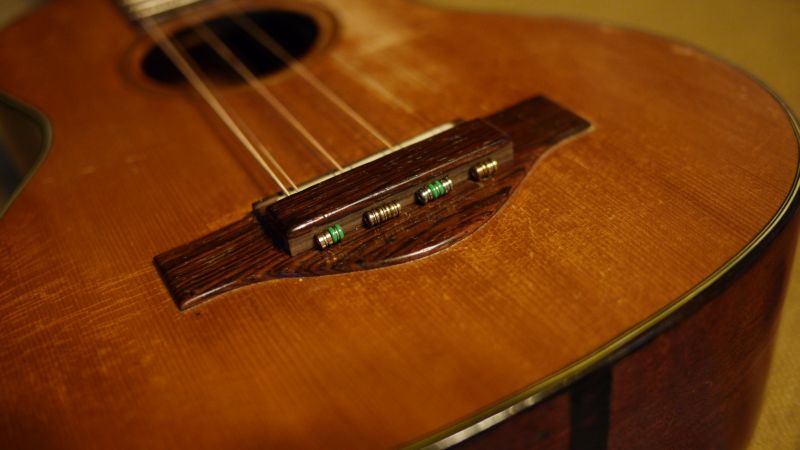Ever Heard of a Martin Tiple?
At various times in my life I’ve surrendered to the urge to collect musical instruments. It’s a common ailment among my peers, and probably one of the less damaging addictions one might suffer. But over the past few years I’ve tried to go straight, stick with the instruments I have and definitely stay away from oddball stuff that once called out to me.
Then I ran across an Ebay auction for a Martin Tiple. Now the “tiple” is one of a number of smallish stringed instruments played throughout the Spanish and Portuguese speaking world, where the word is pronounced “teeplay.” But a Martin Tiple is a strange member of the `ukulele family, an instrument that was vitally important to the CF Martin company in their history. I’ve learned a lot about the Martin Tiple by visiting Uncle Emile’s Blog, The Martin Tiple.
I started off tuning this tiple like a modern tenor uke, G C E A or C6 tuning. But we discovered that it plays and tunes better one step higher in a D6 tuning of A D F# B.
Beauty Shots
There’s something about the organic glow of a fine vintage instrument, the battle scars contribute to the feeling that this is a special object, simply by having survived. The instrument I received from my Ebay seller has been loved pretty hard and had a fair amount of repair work along the way, but the cost reflected that so I’m happy with the result. Martin built these instruments in their common styles of 15/17 (mahogany top, back and sides), 18 (spruce top, mahogany back and sides), and 28 (spruce top, rosewood back and sides). I’ve seen tiples as early as 1925 and as late as the 1970s, this one is from 1949 according to the serial number database on the CF Martin site. It’s easy to see why people fall under the spell of old Martins.
The peghead is one of the most distinctive in the world of stringed instruments, with those five-on-a-plate tuners marching down each side and the forest of strings scurrying over the nut.
This instrument got plenty of legitimate play but not abuse. Looks like someone really had fun with this tiple. If you look carefully you can see that the saddle has been compensated slightly for each course, but not for the intonation difference between the plain and wound strings. This makes tuning accuracy a bit marginal.
The bridge is a block with wings, carved from rosewood with holes drilled through for string attachment. The angled bone saddle drops into a slot in the rosewood.
The ball ends serve to hold the string in place against the bridge. This arrangement gives a very shallow break angle over the saddle, probably adding a bit to the jangle and chime.
There are faintly visible lateral waves in the mahogany back, I can’t tell if it’s a figure in the wood or saw marks from the resawing, but in any case it’s lovely to look at.
So What Does a Tiple Sound Like?
The sound of this little box is pretty amazing. At time it sounds like a 12 string guitar, sometimes like a mandolin, or a Tahitian banjo. It really came to life when Hawaiian slack key and `ukulele master Ledward Kaapana showed up at our house. Ledward told me that one of his Aunties back in Kalapana featured a tiple as her musical contribution to the legendary house parties of his youth. He quickly got the tuning sweetened up and began finding his voice on the tiple.
We’ve been staying pretty busy playing shows around Northern California, but with a few days off I persuaded Ledward to join me in the Digital Duck Studio to do a little video featuring his tiple stylings. I pulled out my Wingert Model E, tuned to taropatch slack key, and we came up with a couple of old Hawaiian songs to share.
How’s that for some jangly fun? If you search around YouTube you can hear some other examples of the tiple being played in a variety of styles.
Recording Details
Since this is a techie blog I should take a moment to address the recording process. I’ve been experimenting with the ORTF mic array lately. It gives a “big” but natural representation of a solo guitar, and I really liked the result in a recent duet recording. So I left the pair of Schoeps cardioid mics in their ORTF arrangement, about two feet in front of our instruments. I used the Panasonic GH2 along with two Sanyo Xacti HD2000 cameras to provide several camera angles.
The audio came through the RME UFX interface and was captured in REAPER. I used no EQ or reverb, the only adjustment was a level boost along with a brickwall limiter to prevent overs. I assembled the audio with the multiple cameras in Edius Neo Booster and rendered as a 720p AVCHD video for upload to YouTube.
This entry was posted on Friday, February 8th, 2013 at 6:43 pm and is filed under Guitar. You can follow any responses to this entry through the RSS 2.0 feed. You can leave a response, or trackback from your own site.






Randy Cordle said in post # 1,
on February 20th, 2013 at 5:28 pm
Hi Fran,
Great example of Tiple and great tunes! The tiple reminds me a bit of a “specialty” instrument that I put together that I call a “Low tuned mandolin”, although the tiple is a lot richer with those triple courses! You can hear a bit of the low tuned mando here:
http://www.youtube.com/watch?v=nhG_nMC7dJE&feature=share&list=UUmGah3yJRPbSC8Z6nCmOBfw
Fran Guidry said in post # 2,
on February 20th, 2013 at 7:15 pm
Thanks, Randy. You certainly seem to be having fun with your instrument variations. Ledward has a lot of success pulling music out of the tiple, I’m having much less success (grin).
Fran
Matt @ Best Acoustic Guitar Strings said in post # 3,
on June 26th, 2013 at 9:31 pm
Wow, what an interesting instrument. That string setup is pretty wild. The sound is pretty unique though, would love to try playing one!
Fran Guidry said in post # 4,
on June 27th, 2013 at 9:59 am
Martin tiples are pretty hard to find. I don’t think they made very many of them compared to ukes and guitars, and the string tension is rather high so a lot of them failed over the years as I understand it. This one could use a neck reset but it’s playable as is so I’m waiting to have the work done.
Thanks for visiting.
Fran
Tom Piggott said in post # 5,
on July 7th, 2013 at 6:27 am
I own a Martin tiple and have no idea as to its value. T-15
149952 is the only # on the inside…all brown, four white dots on Fret board, almost perfect condition, totally playable.In original case too.
Is this worth anything?
Tom
Fran Guidry said in post # 6,
on July 7th, 2013 at 9:47 am
Hi, Tom,
Here’s a page with Martin’s serial numbers. Yours looks like a 1956. The 15 designation indicates mahogany back, sides, and top. Here’s a history page that focuses on the 15 and 17 styles: http://martintiple.blogspot.com/2011/11/martin-tiple-t-17-t-15-models.html
A 1959 sold for $550 last year on Ebay: http://www.ebay.com/itm/1959-Martin-Tiple-T-15-/221085288111
An ad on the Banjo Hangout is asking $950 for a 1965: http://www.banjohangout.org/classified/35249 but there’s no indication it sold at that price.
Those are the only two prices I’ve found in a quick search but they fall in line with my understanding of the market.
Fran
Matthew @ BestGuitarCable.com said in post # 7,
on February 17th, 2014 at 8:21 pm
What a gorgeous sounding instrument. It almost has a banjo-like twang to it but without being so plucky and bright. This would be fun for playing blues.
Fran Guidry said in post # 8,
on February 17th, 2014 at 11:41 pm
Glad you enjoyed it. According to some of the tiple pages I found there were several blues musicians who used the Martin and Regal tiples.
Thanks for visiting,
Fran
Melissa Mills said in post # 9,
on August 29th, 2014 at 7:42 pm
My mother performed all over the West Coast in a singing trio in the mid-30s. She accompanied the group on a 1928 Martin tiple which I still have. Hers had only 8 strings – she may not have known about the 3-string courses – and she played it more like a ukulele, strumming mostly, at least the few times I heard her play it.
Fran Guidry said in post # 10,
on August 29th, 2014 at 10:01 pm
Thanks so much for your visit. I can imagine that this instrument might work better with fewer strings!
We have it tuned like a uke as well, at a different absolute pitch but with the same relation between strings. And most people who play the tiple probably strum it, but Ledward plays his uke with the same fingerpicking style he uses on the guitar or this tiple.
Fran
Mike Mckibben said in post # 11,
on April 18th, 2015 at 12:13 pm
I have what might be a 1924 T17 ser no. 38435
Fran Guidry said in post # 12,
on April 20th, 2015 at 12:55 pm
Hi, Mike,
Do you play your tiple? How has it held up?
Thanks for visiting,
Fran
Nick Hoye said in post # 13,
on June 28th, 2015 at 10:46 am
My buddy found a 1927 T-17 at an estate sale yesterday for $225 which I immediately bought from him before he could ebay it. It shows play where an a few repairs but is in otherwise unbelievably great shape for an almost 90-year old instrument. All white button machines are perfect. I admit I’d never heard of such an instrument and am grateful to all of you for the background and videos. I’m a guitar player who just started experimenting with the mandolin. I have years of woodshedding ahead of me.
Thanks again!
Fran Guidry said in post # 14,
on June 29th, 2015 at 9:04 am
Nick, thanks a lot for stopping by. Sounds like you scored with your T-17.
The usual tuning for a Martin tiple is the same as an `ukulele but with octave strings, similar to a “taropatch fiddle” or 8 string uke.
If you choose to use this normal tuning, you’ll find that the guitar chord shapes work on the tiple, if you were to remove the two lowest pitch strings on your guitar. And the chords will sound a fourth higher, as if you had your guitar capoed at the 5th fret.
Hope you have a lot of fun with it.
Fran
k0k0peli said in post # 15,
on July 4th, 2015 at 3:24 pm
Hi: I’m a long-time guitarist but fairly new to ukes, and very new to uke forums. I had seen the word Tiple in a few forum discussions but paid little attention. Then, just a month ago, at an antiques flea-market 1000 miles away, I saw an odd little instrument, very like my Kala 6-string tenor uke but with more tuning machines. I picked it up. The seller said it was a 1920’s-era Tiple, probably Martin, maybe Regal, but with no name or numbers showing. He asked US$175 including a bombproof ProTec case. I waved US$150 in green bills under his nose, and he accepted. My own Tiple! Such a bargain! (I later traded the case for a soprano uke and a smaller case more suited to my needs.)
This old Tiple is in wonderful shape, showing rather less wear than others of my axes of similar vintage. It’s strung Gg-cCc-eEe-AA and produces a rich, flowing sound. Like the Kala 6-string, it’s not really balanced for solo play and melodic fingerpicking, but it’s sweet for chorded and strummed accompaniment. That little body projects a great deal of sound. I’m just now getting into slack-key ‘uke and plan to explore the sonics of my multi-course tenors. (I also have an 8-string, and a Mexican 12-string cuatro-menor with triple GCEA courses in unison.)
Fran Guidry said in post # 16,
on July 7th, 2015 at 8:06 am
Sounds like you’re building up quite a collection of multi-string uke-ish instruments.
Have you checked the neck block? Should have a “T-??” model number and a serial number if it’s a Martin. Also check back of headstock for the Martin stamp.
I just got my T-18 back from a neck reset and it’s way sweeter than before.
Fran
Jerald said in post # 17,
on August 1st, 2015 at 3:14 am
I have 10 string Tipple do you know of a instruction video on how to play booklet
Fran Guidry said in post # 18,
on August 1st, 2015 at 9:34 am
I don’t know of any instructional material for the tiple, but it is tuned and played like an `ukulele so any uke material applies. Here’s a link to a website with lots of information including how to tune your tiple:
http://martintiple.blogspot.com/p/tunings-strings.html
Fran
Michael Minnig said in post # 19,
on February 4th, 2016 at 12:24 am
Saw your Harlow’s sets last week. Amazing and so aloha! You and Ledward have way to much fun!
Fran Guidry said in post # 20,
on February 4th, 2016 at 8:21 am
Thanks for stopping by Michael and thanks for supporting live Hawaiian music at Harlow’s.
It’s true, we do have way too much fun!
Fran
Charles's Brandt said in post # 21,
on February 13th, 2016 at 3:01 pm
What are the gauges of the strings on the tiple? I have one made in 1950. Martin spec strings don’t work.. I found a set from just strings work pretty good.
Charles
Gary Archer said in post # 22,
on April 28th, 2016 at 11:20 am
I have a early 1928 Martin Tiple #34990…How much do you think it is worth????
Gary Archer said in post # 23,
on April 28th, 2016 at 11:44 am
I also have a 1938 Martin 000-18 #71208 all original ???
Fran Guidry said in post # 24,
on April 30th, 2016 at 10:54 am
Sorry, I’m not a dealer or collector and don’t track values of vintage instruments. Condition and model (18 vs 28) make a big difference in value. You might visit the Unofficial Martin Guitar Forum for some opinions, or contact a dealer for an appraisal.
Fran
Dave Kyle said in post # 25,
on September 21st, 2016 at 1:51 pm
I just bought on with serial # 34770, can anyone help date this? My email is dkyleguitar@gmail.comThanks
Fran Guidry said in post # 26,
on September 21st, 2016 at 2:41 pm
It is my understanding that Martin used the same serial numbers for tiples and guitars. Ukes, however, had no serial numbers.
If your instrument is a Martin, you can look up the serial number here: https://www.martinguitar.com/about/martin-story/serial-number-lookup/
And looking at the table your serial number indicates a 1927 manufacture.
Fran
Tom Draggoo said in post # 27,
on January 5th, 2018 at 4:44 pm
Enjoyed your post on the Martin tiple. Here’s a story for you: I bought a new Martin T28 tiple at a little music store in San Angelo TX in 1974 and played in onstage for a few years, finally trading it in on a 1975 Martin D18 in the early 90s in Eugene OR. When I retired in 2015 my wife said it was too bad I’d traded in that tiple because it was such an unusual instrument, and gave me her blessing to get another one. I found one on eBay and when looking at the pictures noticed a scar in the finish caused by an AKG microphone that had popped back into my tiple in the late 70s. Long story short, I have my old original tiple back. It was an estate sale and I couldn’t get a provenance on it, but that microphone scar told the tale. And I probably bent the curve on the purchase price, but I wasn’t about to let it get away from me.
Fran Guidry said in post # 28,
on January 5th, 2018 at 7:16 pm
Great story, Tom. Thanks for sharing.
Fran
scott said in post # 29,
on January 26th, 2018 at 2:29 pm
Hi, I saw an advert for an old 14 string guitar and as it turns out its a tipple ukulele .. its in poor condition but having played guitar for 40 years and being an antique collector its an amazing looking musical instrument and obviously quite rare ..Its not a Martin but I,ve seen pictures of one identical …unfortunately I cant find the article to properly identify it …I will sell it if somebody is interested
Erick Ericksen said in post # 30,
on September 18th, 2018 at 3:54 am
The first time I ever became familiar with a Tiple was on an episode of Sanford and Son from the 70’s & on the Headstock you could clearly see C.F. Martin. Fred & Smiley Rodgers played in a Vaudeville talent show : )